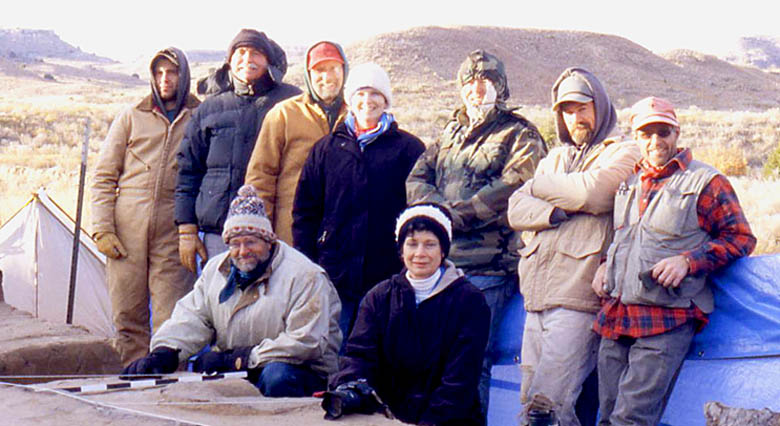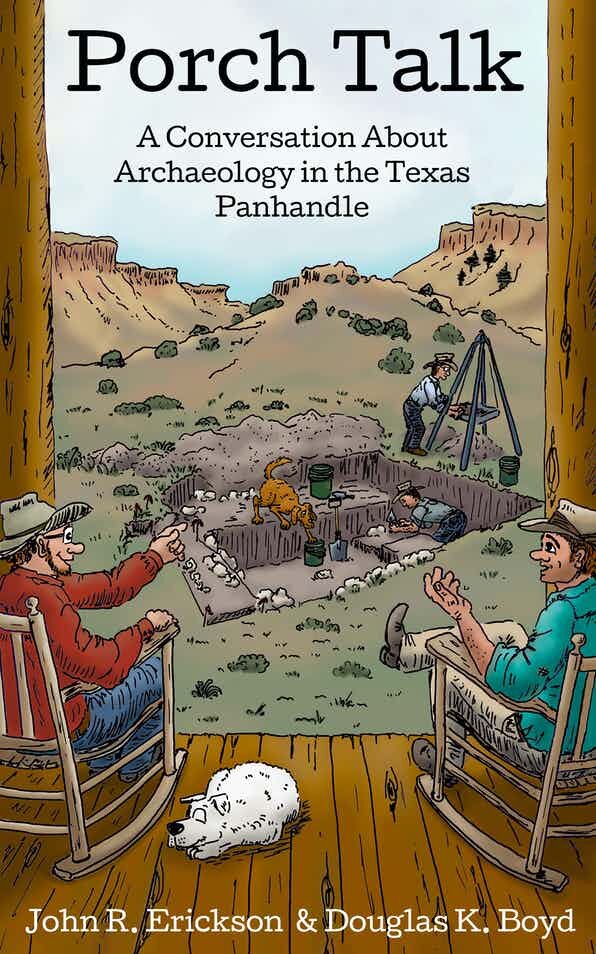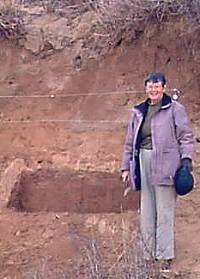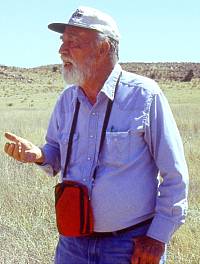Credits & Sources

|
This exhibit was written by Douglas K. Boyd. Doug was raised in the small town of Tulia in the Texas Panhandle. He attended West Texas State University and took classes from Jack Hughes and later earned his Masters degree at Texas A&M. Since 1990 he has been a consulting archeologist for the Austin-based firm Prewitt and Associates, Inc., where Boyd is now Vice President. While his career has taken him all across Texas and beyond, the prehistory of the Texas Panhandle remains his passion. Special thanks go to John and Kris Erickson, gracious hosts who allowed a bunch of archeologists to spend time on their ranch and begin studying the many archeological resources there. Although the work on their ranch has largely been a volunteer effort, the Ericksons have financed many of the special studies, including radiocarbon dates, provided food and lodging for the archeologists, donated supplies, and assisted with travel expenses. TASN steward L. Douglas Wilkens, of Perryton, Texas, worked long and hard on the Hank's site project. Without his efforts, none of the work reported here could have been accomplished. The company Doug works for, BP, provided him with personal development funds that were put toward the logistical arrangements for the field investigations at Hank's site. Brett Cruse, Panhandle regional archeologist for the Texas Historical Commission, provided assistance throughout the planning, fieldwork, and analysis phases. His and the THC's support of the archeological investigations in the West Pasture are always welcome. The following individuals volunteered their time for the Hank's site excavations: Wes and Cindy Anderson, Doug Boyd, Lance Brussard, Brett Cruse, John and Kris Erickson, Mark Erickson, Mike Gilger, Mitch and Reba Jones, Alvin Lynn, Mark Mann, Teddy Lou Stickney, Doug Wilkens, and Reggie Wiseman. A grant from the Texas Archeological Society's Donors Fund provided monies used for the macrobotanical studies by Dr. Phil Dering of Texas A&M University. A grant from the Friends of the Texas Historical Commission's Curtis D.Tunnell Memorial Grant Fund provided monies used to support the artifact cataloguing and analyses, as well as to help with expenses related to producing this web exhibit. Finally, a personal note from Doug Boyd on the passing of two prominent people in Panhandle archeology—Reba Jones and Jack Hughes. A long-time avocational archeologist from Amarillo, Reba volunteered at the Hank's site excavations with her husband, Mitch. This was just one of the many times Reba donated her time and experience to an archeological endeavor. The days she spent at Hank's site in November of 2000 were among her last in the field, as she became ill soon afterwards. Reba passed away in June of 2002, but her many contributions to Panhandle archeology will long be remembered. Jack "dean of Panhandle archeology" Hughes died on May 13, 2001. Our team learned about his death while we were finishing up the excavations at Hank's site. We talked about Jack that night, and his many contributions to Panhandle archeology. His archeological journey included almost half a century of work in the region, and he had influenced many students and professional and avocational archeologists along the way—us included. Jack was always a realist when it came to archeology, and I think he would be the first to admit that all of us who have dabbled in Panhandle archeology over the years are still a bunch of greenhorns with much to learn! Print Sources[This list includes many difficult-to-find scholarly and technical accounts. The *starred items may be of more general interest and more accessible.] Baker, Ele A. and Jewel A. Baker Baerreis, David A., and Reid A. Bryson 1966 Dating the Panhandle Aspect Cultures. Oklahoma Anthropological Society Bulletin 14:105-116. *Bell, Robert E. Brooks, Robert L. 1994 Warfare on the Southern Plains. In Skeletal Biology in the Great Plains: Migration, Warfare, Health, and Subsistence, edited by Douglas W. Owsley and Richard L. Jantz, pp. 317-323. Smithsonian Institution Press, Washington, D.C. Brosowske, Scott 2000 Recent Investigations at Odessa Yates (34BV100): A Plains Village Site in the Oklahoma Panhandle. Oklahoma Archeological Survey Newsletter 20(2):1-2. *Campbell, Robert G. *Drass, Richard R. Drass, Richard R., and Peggy Flynn Drass, Richard R., and Michael C. Moore Duncan, Marjorie Ann Duffield, Lathal Flay Eyerly, T. L. 1907b Archaeological Work in the Texas Panhandle. Bulletin of the Canadian Academy. 1912 The Buried City of the Panhandle. The Archeological Bulletin 3(1):1-5. Hico, Texas. Flynn, Peggy 1986 Analysis of Test Excavations at the Zimms Site (34RM72), Western Oklahoma. In Current Trends in Southern Plains Archaeology, edited by Timothy G. Baugh, pp. 129-140. Plains Anthropologist 31(114, Pt. 2) Memoir 21. Green, F. Earl Gunnerson, James H. Habicht-Mauche, Judith A., Alytia A. Levendosky,
and Margaret J. Schoeninger Hall, Stephen A. Harrison, Billy R. Hofman, Jack L. Holden, W. C. Hughes, David T. Hughes, David T., and Alicia Hughes-Jones Hughes, Jack T. 1968 Prehistory of the Caddoan-Speaking Tribes. Unpublished Ph.D. dissertation, Columbia University, New York. *1991 Prehistoric Cultural Developments on the Texas High Plains. Bulletin of the Texas Archeological Society 60:1-55. *Keeley, Lawrence H. Krieger, Alex D. 1978 The Southern Limits of Central Plains Culture Complexes. Proceedings of the Fifth Plains Conference for Archeology, assembled by John L. Champe, pp. 98-99. Reprint of 1949 Laboratory of Anthropology Note Book No. 1. University of Nebraska, Lincoln. *LeBlanc, Steven A. Lintz, Christopher 1982 An Overview of the Antelope Creek Focus. Transactions of the 17th Regional Archeological Symposium for Southeastern New Mexico and Western Texas, pp. 37-56. *1984 The Plains Villagers: Antelope Creek. In Prehistory of Oklahoma, edited by Robert E. Bell, pp. 325-346. Academic Press, New York. *1986 Architecture and Community Variability within the Antelope Creek Phase of the Texas Panhandle. Studies in Oklahoma's Past No. 14. Oklahoma Archeological Survey, Norman. 1991 Texas Panhandle-Pueblo Interactions from the Thirteenth through the Sixteenth Century. In Farmers, Hunters, and Colonists: Interaction between the Southwest and the Southern Plains, edited by Katherine Spielmann, pp. 89-106. University of Arizona Press, Tucson. Shaeffer, James B. Studer, Floyd V. 1955 Archeology of the Texas Panhandle. Panhandle-Plains Historical Review 28:87-95. Vehik, Susan C. 1990 Late Prehistoric Plains Trade and Economic Specialization. Plains Anthropologist 35(128):125-145. Wedel, Waldo R. *1986 Central Plains Prehistory: Holocene Environments and Culture Change in the Republican River Basin. University of Nebraska Press, Lincoln. Wilson, Gilbert L. Links
NEW 2022 Porch Talk: A Conversation About Archaeology in the Texas Panhandle
http://www.hankthecowdog.com/author
Hank's House 2: A Puzzle Wrapped in Mystery
|
|

